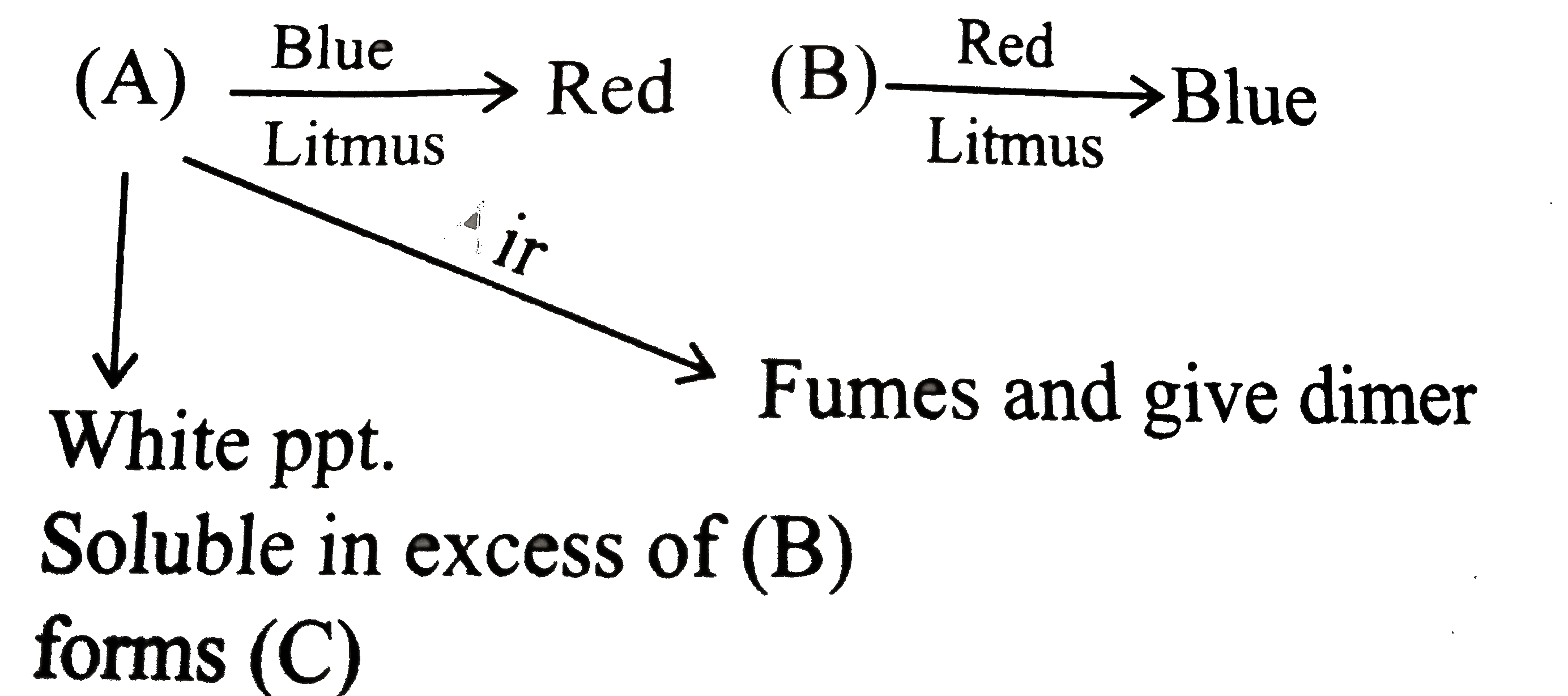On reaction with Cl2 phosphorus forms two types of halides 'A' and 'B'.
Halide 'A' is yellowish- white powder but halide 'B' is colourless oily liquid.
Identify A and B and write the formulae of their hydrolysis products.
Since Cl2 reacts with phosphours to form two halids (A and B), therefore, thses halides must be PCl3andPCl3. Since halide 'A' is a yellowish-white solid but halide 'B' is a colourless oily liquid, therefore, due to higher molecular mass and hence stronger forces of attraction, halide 'A' must be a solid, i.e., PCl5 and
P4+10Cl2→4PCl3 (yellowish-white solid)
P4+6Cl2→4PCl3(B) (colourless oily liquid)
halide 'B' must be a liquid i.e., PCl3.
Their hydrolysis products are shown below :
PCl5Phosphorus pentachloride+4H2O→H3PO4Orthophosphoric acid+5HCl
PCl3Phosphorus trichloride+3H2O→H3PO3Phosphorus acid+3HCl
Topper's Solved these Questions
- P-BLOCK ELEMENTS (NITROGEN FAMILY)Book:PRADEEPChapter:P-BLOCK ELEMENTS (NITROGEN FAMILY)Exercise:NCERT EXEMPLAR PROBLEMS WITH ANSWERS, HINTS AND SOLUTIONS (MULTIPLE CHOICE QUESTIONS-II)
Explore 1 Video
- P-BLOCK ELEMENTS (NITROGEN FAMILY)Book:PRADEEPChapter:P-BLOCK ELEMENTS (NITROGEN FAMILY)Exercise:NCERT EXEMPLAR PROBLEMS WITH ANSWERS, HINTS AND SOLUTIONS (Assertion And Reason Type Questions)
Explore 2 Videos
- P-BLOCK ELEMENTS (NITROGEN FAMILY)Book:PRADEEPChapter:P-BLOCK ELEMENTS (NITROGEN FAMILY)Exercise:NCERT QUESTIONS AND EXERCISES WITH ANSWERS (NCERT (EXERCIES))
Explore 16 Videos
- ORGANIC CHEMISTRY-SOME BASIC PRINCIPLES TECHNIQUESBook:PRADEEPChapter:ORGANIC CHEMISTRY-SOME BASIC PRINCIPLES TECHNIQUESExercise:Competition Focus (Jee (Main and Advanced)/Medical Entrance) VIII. Assertion-Reason Type Questions
Explore 25 Videos
- REDOX REACTIONS Book:PRADEEPChapter:REDOX REACTIONS Exercise:Assertion reason type question
Explore 16 Videos
Similar Questions
On reaction with Cl2 phosphorus forms two types of halides 'A' and 'B'.
Halide 'A' is yellowish- white powder but halide 'B' is colourless oily liquid.
Identify A and B and write the formulae of their hydrolysis products.
View SolutionA compound 'X' which is a yellowish white powder is prepared by the reaction of white phosphours with excess of dry Cl2. Identify 'X'
View Solution
Knowledge Check
On reaction with Cl2, phosphorus forms two types of halides 'A' and 'B'. Halide 'A' is yellowish-white powder but halide 'B' is colourless oily liquid. What would be the hydrolysis products of 'A' and 'B' respectively?
AH3PO4,H3PO3BHOPO3,H2PO2CH3PO3,H3PO4DHPO3,H3PO3A colourless mixture of two salts (A) and (B) [excess] is soluble in H2O.

Identify BAAI(OH)3BZn(OH)2CNaOHDNone of theseA white 'A' on heating decomposes to produce two products 'B' and 'C'. 'B' on reaction with white phosphorous produces 'D', which is a strong dehydrating agent. 'D' on reaction with perchloric acid converts it to its anhydride.
The product obtained on hydrolysis (complete) of D is:Amixture of H3PO3 and H3PO4Bonly PH3Conly H3PO4Dmixture of H3PO3 and H3PO2
CoSO4Cl.5NH3 exists in two isomeric forms 'A' and 'B'. Isomer 'A' reacts with AgNO3 to give white precipitate, but does not react with BaCl2. Isomer 'B' gives white precipitate with BaCl2 but does not react with AgNO3. Answer the following questions.
(a) Identify 'A' and 'B' and write their structural formulae.
(b) Name the type of isomerism involved.
(c) Give the IUPAC name of 'A' and 'B'.
View SolutionThe reaction of acetophenone with Br2 and KOH forms products A and B. find A and B are
View Solution(a) Name two interhalogens of AB3 type.
(b) Write the hydrolysis product of lC l?
View SolutionCoSO4Cl.5NH3 exists in two isomeric forms 'A' and 'B'. Isomer 'A' reacts with AgNO3 to give white precipitate, but does not react with BaCl2. Isomer 'B' gives white precipitate with BaCl2 but does not react with AgNO3. Answer the following questions.
(a) Identify 'A' and 'B' and write their structural formulae.
(b) Name the type of isomerism involved.
(c) Give the IUPAC name of 'A' and 'B'.
View SolutionA white substance a reacts with dilute H2SO4 to produce a colourless gas B and a colourless solution C. The reaction between B and acidified K2Cr2O7 solution produces a green solution and a slightly coloured precipitate D. The substance D burns in air to produce a gas E which reacts with B to yield D and a colourless liquid. Anhydrous copper sulphate is turned blue on addition of this colourless liquid. Additio of aqueous NH3 or NaOH to C produces first a precipitate, produce a clear solution in each case. Identify A, B, C, D and E. Write the equations of the reactions involved.
View Solution

